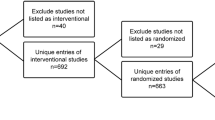Abstract
Exposure adjusted incidence rate (EAIR) and exposure adjusted event rate (EAER) are two commonly used measures for adverse event risk in clinical trials. However, in clinical trials with treatment crossover, classical EAIR and EAER should be adapted before being used due to the presence of within subject correlation. In this paper, we review the definition and motivation of EAIR and EAER, discuss how we can use mixed-effect models and generalized estimating equations to adapt EAIR and EAER to the treatment crossover case, and evaluate the proposed methods on synthetic trial data. We aim to combine both theory and practicality – while presenting sufficient theoretical motivation and justification, we also provide the SAS code for the proposed methods and discuss the practical issues one might encounter when applying them.
Similar content being viewed by others
References
Fine JP, Jiang H, Chappell R (2001) On semi-competing risks data. Biometrika 88(4):907–919
He Xin, Chen Li, Lei Lei H, Xia Amy, Lee Mei-Ling Ting (2015) A simple method for estimating confidence intervals for exposure adjusted incidence rate and its applications to clinical trials. J Biom Biostat. https://doi.org/10.4172/2155-6180.1000238
Heitjan DF (1993) Ignorability and coarse data: some biomedical examples. Biometrics 49(4):1099–1109
Jiang H, Chappell R, Fine JP (2003) Estimating the distribution of nonterminal event time in the presence of mortality or informative dropout. Control Clin Trials 24:135–146
Robert W (2010) Keener. Theoretical Statistics Topics for a Core Course. Springer-Verlag, New York
Timothy L. Lash Kenneth J. Rothman, Sander Greenland. 2008 Modern Epidemiology. Lippincott Williams & Wilkins
Lavange LM, Keyes LL, Koch GG, Margolis PA (1994) Application of sample survey methods for modelling ratios to incidence densities. Stat Med 13(4):343–355
Lin DY, Robins JM, Wei LJ (1996) Comparing two failure time distributions in the presence of dependent censoring. Biometrika 83(2):381–393
Lin DY, Wei LJ, Yang I, Ying Z (2000) Semiparametric regression for the mean and rate functions of recurrent events. J Royal Stat Soc: Series B (Stat Methodol) 62(4):711–730
G. Frank Liu. On analysis of low incidence adverse events in clinical trials. In Topics in Applied Statistics (2012) Symposium of the International Chinese Statistical Association. Springer, New York, p 2012
Frank Liu G, Wang Junyuan, Liu Kenneth, Snavely Duane B (2006) Confidence intervals for an exposure adjusted incidence rate difference with applications to clinical trials. Stat Med 25(8):1275–1286
Menjoge SS (2003) On estimation of frequency data with censored observations. Pharm Stat 2:191–197
Wayne B. Nelson. 2003 Recurrent Events Data Analysis for Product Repairs, Disease Recurrences, and Other Applications. Society for Industrial and Applied Mathematics
Rosenkranz G (2006) Analysis of adverse events in the presence of discontinuations. Drug Inf J 40(1):79–87
Shan G (2015) Exact unconditional testing procedures for comparing two independent poisson rates. J Stat Comput Simul 85(5):947–955
Zhou Y, Ke C, Jiang Qi, Shahin S, Snapinn S (2015) Choosing appropriate metrics to evaluate adverse events in safety evaluation. Therap Innov Regul Sci 49(3):398–404
FDA reviewer guidance: conducting a clinical safety review of a new product application and preparing a report on the review.
Acknowledgement
This manuscript was sponsored by AbbVie. AbbVie contributed to the design, research, and interpretation of data, writing, reviewing, and approving the content. Yunxia Sui, Yihan Li, and Xin Wang are employees of AbbVie Inc. Ruofei Zhao was a summer intern at AbbVie and a graduate student at the University of Michigan when he contributed to the research and the writing of this manuscript. All authors may own AbbVie stock.
Author information
Authors and Affiliations
Corresponding author
Supplementary Information
Below is the link to the electronic supplementary material.
Rights and permissions
About this article
Cite this article
Sui, Y., Zhao, R., Li, Y. et al. Exposure Adjusted Incidence Rate and Event Rate in Clinical Trials with Treatment Crossover. Stat Biosci 14, 66–78 (2022). https://doi.org/10.1007/s12561-021-09314-6
Received:
Revised:
Accepted:
Published:
Issue Date:
DOI: https://doi.org/10.1007/s12561-021-09314-6




